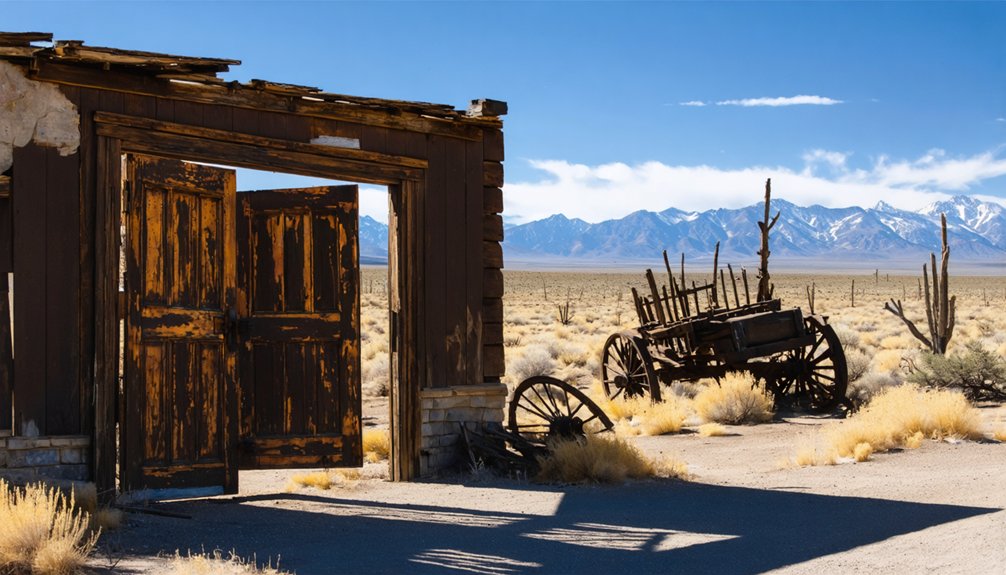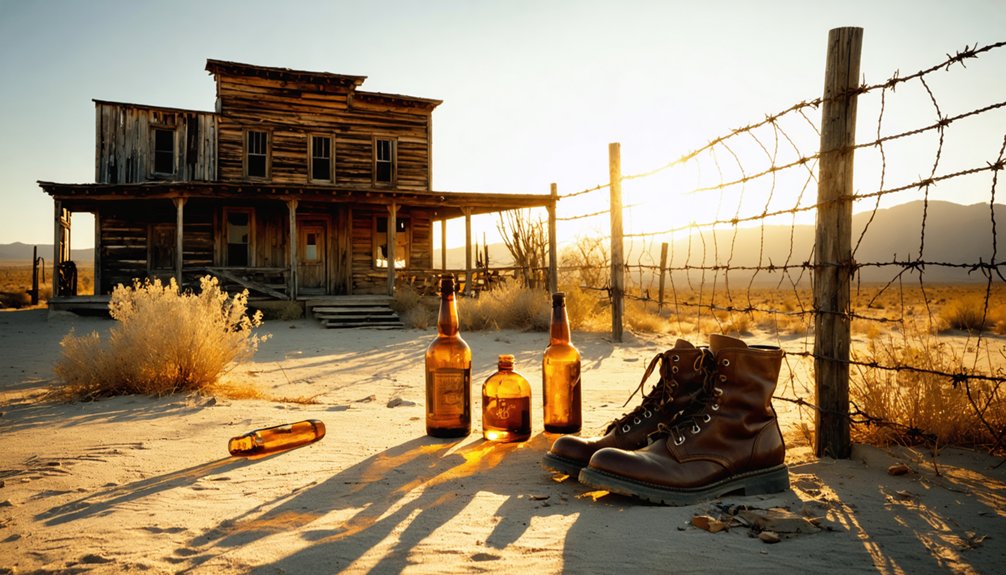When exploring Nevada’s mining towns, always research site locations using NBMG resources before you go. Pack safety gear including hard hats, steel-toed boots, and emergency supplies. Travel with companions and share your route with someone reliable. Understand the unique geology that created Nevada’s mineral wealth. Respect preservation efforts by obtaining permits and never disturbing artifacts. Navigate carefully with high-clearance vehicles. Document your findings with detailed photographs. These preparations will transform your journey from simple sightseeing to meaningful historical exploration.
Key Takeaways
- Pack safety gear including hard hat, eye protection, steel-toed boots, respiratory protection, and emergency supplies when exploring mining sites.
- Research thoroughly using resources like Nevada Bureau of Mines and Geology reports and historical maps to accurately locate sites.
- Respect preservation efforts by obtaining necessary permits, avoiding trespassing, and never removing artifacts from their original locations.
- Use high-clearance 4WD vehicles for rough terrain and always share your route with someone reliable before departing.
- Visit during spring or fall for ideal weather conditions and bring companions for safety when exploring remote mining towns.
Research Historic Mining Sites Before Your Journey
Before starting your Nevada mining town adventure, you’ll need to access thorough research materials to locate these historic sites accurately.
Proper preparation means gathering detailed maps and historical documents before venturing into Nevada’s forgotten mining districts.
Begin with the Nevada Bureau of Mines and Geology (NBMG) Report 47, the standard reference for district names and locations, along with their digital resources containing PDFs of historical documents.
Utilize interactive mining district maps and GIS data available through NBMG for your exploration planning. Historical maps like the 1946 Map of Mining Districts and Schilling’s Map 37 provide valuable context for older sites. For the most current data, visit the collections database at https://collections.nbmg.unr.edu/ since the previous site is no longer maintained.
The C.L.A.I.M.S. Location Array offers interactive mapping of mining claims across Nevada, while ExpertGPS provides downloadable GPX files for nearly 4,000 mines organized by town.
Ron Hess’s project site contains over 25,000 digitized documents and maps.
The Nevada Historic Mining Districts Map displays historically produced commodities that can provide valuable insights into what minerals were extracted from each site you plan to visit.
Pack Essential Safety Gear for Remote Exploration
When exploring abandoned mining towns across Nevada’s remote landscapes, you’ll need thorough safety gear to protect yourself from potential hazards. Always wear a hard hat that meets ANSI Type II specifications to guard against both top and lateral impacts.
Don’t forget eye protection—goggles shield against dust and debris common in these historic sites. Proper footwear is essential; choose steel-toed boots rather than running shoes for stability and protection. High-visibility clothing helps in case of emergency rescues.
Pack respiratory protection for areas with potential dust hazards or poor ventilation. Be sure to bring breathing apparatus that is NIOSH approved when entering areas that might contain toxic gases or be oxygen deficient. When exploring areas with steep terrain like the 50-foot stove described in the Nevada site, always use a rope for safe descent and climbing. If you’re exploring elevated structures, bring fall protection equipment including harnesses and lanyards that meet regulatory requirements.
Your safety equipment should include emergency supplies like extra water, first aid kit, and communication devices. Remember, even short falls in mining structures can cause serious injuries.
Understand the Geology Behind Nevada’s Mineral Wealth
Nevada’s remarkable mineral wealth stems from complex geological processes dating back millions of years.
When exploring mining towns, you’ll encounter formations created 40 million years ago during intense igneous activity that formed the famous Carlin Trend. These geological formations feature fault zones and fractures that channeled mineral-rich fluids, creating the deposits you’re searching for during mineral exploration. The Carlin Trend has produced over 1,600 metric tons of gold since its discovery in 1961. Most of Nevada’s gold exists as native gold and is often accompanied by silver in quartz-rich hydrothermal veins.
- Gold appears as microscopic particles in sedimentary rocks, invisible to your naked eye
- Silver-rich fissure veins cut through limestone and dolomite like ancient lightning strikes
- Fault structures create a natural underground highway system for mineral deposition
- Volcanic events from the Mesozoic era crafted polymetallic ore bodies now waiting to be discovered
- Unexplored areas beneath valley sediments hide potential treasures for the adventurous explorer
Respect Preservation Efforts and Cultural Heritage
As you explore Nevada’s historic mining towns, respecting preservation efforts and cultural heritage must become a fundamental part of your journey.
Remember that structures like the Florence Mine in Goldfield may appear sturdy but often face critical structural challenges from missing timbers, foundation settlement, and weather exposure.
Understand that National Register status doesn’t guarantee protection—the Huntridge Theatre and Lear Theatre remain vulnerable despite their designation.
National Register designation offers recognition but not automatic salvation for Nevada’s historic treasures.
Support community involvement through local events like Goldfield Days, where heritage education happens through parades, tours, and exhibits.
Organizations like Preserve Nevada and the Goldfield Historical Society work tirelessly to identify endangered sites and secure grant funding.
Be aware that many historic markers throughout Nevada have suffered from maintenance issues since 2009 budget cuts, with approximately 270 markers currently damaged or containing incorrect information.
Your mindful exploration helps guarantee these irreplaceable engineering achievements—headframes, hoist houses, and historic buildings—survive for future generations to experience Nevada’s rich mining legacy.
When visiting iconic structures like the Goldfield Hotel built by George Wingfield in 1908, remember its historical significance as one of the most luxurious establishments in the American West.
Exploring Nevada’s mining towns requires thorough preparation before you venture onto the challenging terrain that surrounds these historic sites.
Successful terrain maneuvering depends on timing your visit during spring or fall when weather conditions are ideal. Always check recent trail reports and weather forecasts, as unpaved roads quickly become impassable after rain or snow. When approaching areas like Petersen Mountain, be aware of extensive mining claims and ensure you’re not trespassing on private property. Remember that certain routes like the Bullfrog Historic Mining District feature steep ledges that require careful navigation, though most of the trail remains non-technical.
- Your high-clearance 4WD vehicle crawling over deeply rutted washouts near abandoned mine entrances
- Your GPS guiding you along unmarked trails as dust billows behind your tires
- Your wheels carefully maneuvering rocky inclines where cell service disappeared miles ago
- Your headlights illuminating a narrow mountain pass as the sun sets over distant peaks
- Your vehicle parked safely at your destination after traversing challenging backcountry roads
Road safety demands bringing emergency supplies, traveling with companions, and always sharing your route with someone reliable.
Photograph Mining Relics Responsibly
Photographing mining relics requires the same level of care and respect you’d give to any historical treasure. Before capturing images, obtain necessary permits for protected lands and verify you aren’t trespassing on private property or active claims.
Mining artifacts are historical documents—photograph with care and only after securing proper access permissions.
When practicing ethical photography, never move or disturb artifacts for a better shot—document them exactly as found. Shoot in RAW format with stable tripods to maximize detail in your relic documentation, especially in low-light conditions. Include scale references to provide context about size and proportions.
Maintain a safe distance from fragile structures, using non-invasive techniques to protect site integrity. After photographing, guarantee you leave no trace of your visit.
Remember to organize your digital files with detailed metadata and consider sharing discoveries with local historical societies to support preservation efforts.
Connect With Local Historical Societies

Local historical societies throughout Nevada hold the keys to understanding the state’s rich mining heritage. When visiting mining towns, connect with organizations like the Goldfield Historical Society or Carson City Historical Society to access historical resources that bring the past to life.
These societies coordinate regional documentation efforts and often host local events that illuminate mining-era stories.
- Examine the Nevada Historical Society’s 1,000+ photographs of Paiute, Washoe, and Shoshone people who inhabited mining regions
- Visit Tonopah Historic Mining Park to learn about Belle Butler’s Mizpah Mine that revitalized Nevada’s economy
- Explore Beatty Museum’s collections documenting northwestern Nevada’s mining communities
- Attend Douglas County Historical Society presentations on eastern Nevada mining districts
- Discover Rhyolite’s documented history of boom and abandonment following the 1907 financial panic
Frequently Asked Questions
Are Permits Required for Metal Detecting at Abandoned Mining Sites?
Yes, you’ll need written permits for metal detecting at abandoned mining sites on public lands. Metal detecting regulations are strict due to these locations’ historical significance, especially for sites over 100 years old.
How Dangerous Is Abandoned Mine Water Compared to Natural Springs?
Abandoned mine water is DEADLY compared to natural springs. You’ll encounter catastrophic abandoned mine hazards with acidic pH and toxic metals, while natural springs typically maintain safe water quality for exploration.
What Should I Do if I Find Valuable Minerals?
First, verify mineral identification through testing. Document your discovery’s location. If on public land, file proper mining claims to establish legal ownership. Don’t remove more than 500 pounds until you’ve secured title.
Can I Camp Overnight in Ghost Mining Towns?
In the vastness of Nevada’s desert night, you can’t legally camp inside ghost towns. Follow camping regulations by staying at designated sites nearby. Ghost town etiquette demands you respect historic structures while enjoying freedom in surrounding public lands.
Which Mining Towns Are Wheelchair or Limited Mobility Accessible?
Truckee offers 26.6 miles of wheelchair-friendly trails with adaptive equipment options. In Nevada City, you’ll find Hirschman Trail with accessible segments. Malakoff Diggins provides the Overlook Trail, while Eldorado Canyon offers accessible tours requiring collapsible wheelchairs.
References
- https://visitvirginiacitynv.com/history/
- http://epubs.nsla.nv.gov/statepubs/epubs/210988-2007.pdf
- https://nbmg.unr.edu/mining/MiningHistory.html
- https://minerals.nv.gov/uploadedFiles/mineralsnvgov/content/Programs/Mining/MiningForms/es2020_text.pdf
- https://savingplaces.org/stories/explore-wild-west-mining-history-in-nevada-ghost-towns
- https://ronhess.info/docs/mi/02.pdf
- https://www.youtube.com/watch?v=Bp2IcEQsWEM
- https://ronhess.info/docs/mi/03.pdf
- https://nevadamining.org/new-history-page/
- https://minerals.nv.gov/uploadedFiles/mineralsnvgov/content/Programs/Mining/MiningForms/es2020_text.pdf?csrt=5569804669375258325



